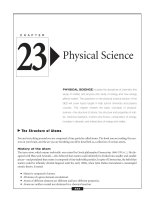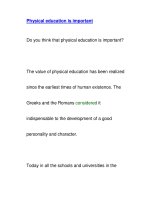Total physical pespond POWERPOINT
Bạn đang xem bản rút gọn của tài liệu. Xem và tải ngay bản đầy đủ của tài liệu tại đây (1.07 MB, 29 trang )
Welcome to our TPR class.
TPR ROUTE
1. The introduction of TPR
2. Experience from a real TPR class
3. The Inferences from the experience
4. Principle review
5. Technique review
6. Micro-teaching
THE INTRODUCTION OF TPR
What is TPR?
- Total physical Response
- Based on the coordination of speech and physical movement.
- Instructors give commands to students in the target language, and students respond
-
with whole-body actions.
Linked to the “trace theory” of memory psychology (Katona 1940)
Background:
-
Asher developed TPR as a result of his experiences observing young children learning
their first language.
-
Most of the interactions that young children experience with parents or other adults
combine both verbal and physical aspects Children respond physically before they
begin to produce verbal responses.
-
Asher made three hypotheses based on his observations
The method is an example of the comprehension approach to language teaching:
• Comprehension abilities precede productive skills in learning language
• The teaching of speaking should be delayed until comprehension skills are established
• Skills acquired through listening transfer to other skills
• Teaching should emphasize meaning rather than form
• Teaching should minimize leaners’ stress
In the book English through actions: “ No method of teaching foreign speech is likely to
be economical or successful which does not include in the first period a very
considerable proportion of that type of classroom work which consists of the carrying
out by the pupil of orders issued by teacher” (Palmer)
EXPERIENCE FROM A REAL TPR CLASS
•
•
•
•
•
•
•
•
Teacher will present and explain the approach they will use to learn English in L1, in
particular, Swedish.
Ask four volunteer Ss to come and do what he requires in L2 with him.
“Stand up” the teacher does and Ss follow.
Say and do another one “Sit down” and Ss follow.
Do the two orders several times through the teacher’s command.
A new order “Turn around”. The volunteers act out with the teacher.
Use this command again for Ss to face to the class.
“Sit down. Stand up. Turn around. Sit down”
•
•
The new command “Walk”. Ss walk towards the class together.
•
Performs these commands again and changes the positions of them “Stand up. Jump.
Sit down. Stand up. Turn around. Jump. Stop. Turn around. Walk. Stop. Turn around.
Walk. Jump. Turn around. Jump. Sit down”. Faster.
•
A series of command “Stop. Jump. Stop. Turn around. Walk. Stop. Jump. Stop. Turn
around. Sit down”.
The teacher does not move. Sit and give orders “Stand up. Sit down. Walk. Stop. Jump.
Turn around. Walk. Turn around. Sit down”.
•
•
•
•
•
•
One of the four Ss follows the teacher’s commands
Turning to the rest of the class and giving the order “Stand up”.
A series of commands is said “Sit down. Stand up. Jump. Stop. Sit down.
Stand up. Turn around. Turn around. Jump. Sit down”. Ss are able to carry
out these commands.
Insert the new command “Point to the chair”.
“Stand up” / “Point to the door” / “Walk to the door” / “Touch the door”.
A variety of commands “Point to the desk. Walk to the desk. Touch the
desk. Point to the door. Walk to the door. Touch the door. Point to the
chair. Walk to the chair. Touch the chair”.
•
•
Practice the orders several times through the teacher’s command together.
•
Turn to the rest of the class & give a series of commands “Stand up. Sit down. Stand
up. Point to the desk. Point to the door. Walk to the door. Walk to the chair. Touch the
chair. Walk. Stop. Jump. Walk. Turn around. Sit down”.
•
•
Give order one more time. No movement. Say the commands & act them out when Ss
are confused.
Turn to the four Ss and orders “Stand up. Jump to the desk”. they may pause for a
moment.
Give the unpracticed commands “Touch the desk. Sit on the desk”.
•
•
•
•
Put the commands in the compound sentence “Point to the door and walk
to the door”.
Show the new orders on the board and perform in each action.
Ss takes note the commands on their notebooks.
One of the Ss is commanding to the other Ss and the teacher “Raise your
hands. Show me your hands. Close your eyes. Put your hands behind you.
open your eyes. Shake hands with your neighbor. Raise your left foot”.
THE INFERENCES FROM THE EXPERIENCE
OBSERVATIONS
1. First of all, three simple commands are said
and teacher act them out.
2. Students onely hear and perform the
commands with the teacher.
3. The teacher combines the commands by
saying them quickly while acting them out
with the volunteers.
PRINCIPLES
To memorize the meaning of the commands
by observing teacher’s actions and to imitate the
teacher.
To understand the meanings related with
actions before speaking.
By copying teacher’s actions, students can
get basic understanding of the target language.
OBSERVATIONS
4. Say the commands , stays still and only
students perform the commands.
5. Gives the commands to who have not
performed yet.
6. New commands are introduced only after
student have mastered the previous ones.
7. After a combination of commands, the order
of them will be changed.
PRINCIPLES
Memorize the language by listening to
teacher’s commands, not by imitating
Learn the target language through observing
actions and by acting out.
The feeling of success and being less
confused motivate students.
Avoid memorizing the commands through a
fixed order.
OBSERVATIONS
8. When students make an error, the teacher
repeats the command while acting it out.
9. Teacher gives the students commands that they
have not heard before.
PRINCIPLES
Correction should be carried out in an
unobtrusive manner.
They must develop the ability of understanding,
novel combination of target language chunks.
Students need to understand more than the exact
sentences used in training. Novelty is motivating.
10. Teacher says ‘Jump to the desk’. Everyone
laughs.
Sometimes fun situation helps students
comprehend the language more easily.
OBSERVATIONS
11.Teacher writes the new command on the
black board.
12.A few weeks later, a student who hasn’t
spoken before gives commands.
13.A student says “shake hand with your
neighbor”.
PRINCIPLES
In language teaching, spoken languages should
be emphasized over written ones.
That student has enough motivation to begin to
speak, students will speak when they are ready.
Students can make mistakes when they first
begin speaking. So, teacher should take time and work
on the fine details of the languages. The errors should
be postponed until students have become more
proficient.
PRINCIPLE REVIEW
1. Objectives of the teacher:
•
•
To have Ss enjoy their experience in learning to communicate in L2.
To reduce stress when studying L2.
2. Teacher’s and Learners’ roles:
Teacher’s role
Teacher plays an active and direct role in TPR.
Students’ role
Learner has the primary roles of listener an
performer
Learners are imitators of teacher’s
nonverbal model.
Learners have little influence over the
content of learning.
3. Major characteristic of TPR:
A few students are asked to follow teacher’s commands and actions.
students perform the commands alone to prove that they understand the
These
requirements.
commands will be recombined to have students develop flexibility in understanding
The
unfamiliar utterances.
The commands are often humorous.
Students learn how to read and write the given oral commands.
When students are ready to speak, they become the ones who issue the commands.
After beginning speaking, students expand the activities including skits and games.
4. The nature of Student – teacher
vs Student – student interaction:
Phase
1
Teacher
interacts and speaks with both the whole group of students
Students
respond nonverbally.
and with individual students.
2
responds nonverbally.
become more verbal.
3
Must demonstrate Ss’ understanding of the commands
perform actions together.
Begin to speak.
Had better issue commands to one
another as well as to the teacher.
5. Ways to deal with learners’ feelings?
Allow students to speak when they are ready.
Make language learning as enjoyable as possible.
Not provide too much modelling.
Should not expect the perfection.
6. How is language viewed? How is culture viewed?
With the acquisition of the native language, the oral modality is primary.
Culture is the lifestyle of people who speak the language natively.
7. What areas of language are emphasized? What language skills are emphasized?
Vocabulary and grammatical structures are emphasized
They are embedded within imperatives with single words and multi- word chunks.
The spoken language is emphasized over written language.
8. What is the role of the students’ native language?
TPR is usually introduced in the student’s native language
Meaning is made clear through body movements.
9.How is evaluation accomplished?
Teacher will know immediately whether or not students understand by observing their
students’ actions.
10. How does the teacher respond to student errors?
Teachers should be tolerant of them and only correct major errors.
As students get more advanced, teachers can “ fine tune”- correct more minor errors.
TECHNIQUE REVIEW
A. USING COMMANDS TO DIRECT BEHAVIOR:
The use of commands which are acted out.
Meaning are conveyed through actions.
Preparation for commands in advance keeps students’ interest.
Main steps in a TPR lesson:
•
•
•
Teacher says and performs several basic commands and student copy them.
Next, only students carry out the commands said by the teacher.
Then several mixed sequences of the commands are introduce to better students’
memory of the language.
Notice:
The mastery of commands and the pleasure of succeeding are priority, so any rush for
new commands is not recommended.
Asher believes that teachers can base TPR method on teaching all grammatical points
for a particular level of learners.
B. DEMONSTRATION:
Introducing commands:
1) First stage: “cook” - “eat” - “drink”
2) Next stage: “wash my hands” - “clean the table” - “take a shower”
3) Action sequence: “cook – eat – drink – wash my hands – clean the table – take a
shower”









